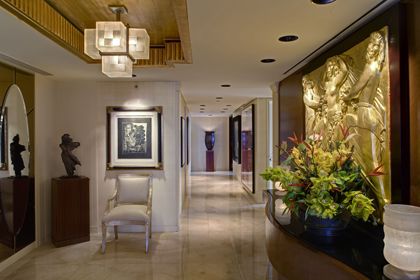When a client calls a designer for an appointment to interview each other, it is somewhat understood they need your help otherwise they would not have called you. While some clients don’t know how to express themselves, a designer MUST know how to interpret their comments and ask the appropriate questions.
For the Designer
Some clients will say the most outrageous things to their designer trying to get the designer to know what they want, but they don’t always use the correct terms. Once a client told me she “HATED†Art Deco, however whenever we shopped together, she only like those pieces which were Art Deco inspirations. When I pointed this out to her, she was astonished….what she really hated was early American…go figure. Some clients will tell you they hate antiques while their spouse loves antiques. Suggest a compromise, not one which will create one room of antiques, but integrate antiques in a contemporary manner, such as a French Bombe chest with a contemporary painting, lamp and area rug in a hallway, or minimize the amount of traditional or antique pieces so there is a well-rounded balance of contemporary and antiques.
The key is to listen and give them what they want, however it has to work well together and meet with your approval as well as the client’s. While you should never compromise your beliefs, you must always convey your opinions in a direct yet courteous manner to your client and your client should do the same with you. Often, I can’t get a client to do what I know to be the best options for their home, however I will let them know this is not what I think is best, but that they have to live with their decisions…I then at that moment will know if I will be able to photograph their home for my portfolio or not…some clients won’t care but they should have what they want.
For the Client
When you decide to work with the designer of your choice, discuss with them any and all issues facing the overall project, whether is it differences you and your spouse have, pieces from Grandma, budgets, and expectations, but remember, you will get an opinion which is not yours and you need to be open and listen to the suggestions. You may be surprised your designer can do this with such little effort, but if you know you won’t like these ideas, let them know in a polite manner for we don’t read minds, and we only give opinions which will work if we know all of the parameters. Changing your mind is okay, but making this a habit will drive your designer crazy and if you plan any deceptions, it will backfire…be open and honest without any fear…if you are, then there should be no surprises.
For the Designer
Sometimes it is a question of expense, or a reminder of their old Aunt Jane’s house, or some other preconceived influence over their decision process. Give them alternatives they can afford or a piece which will achieve their idea of how they see themselves. Remember, you don’t live there, yet you do need to be proud of your work…sometime it simply won’t work, so then it is only a paycheck and a satisfied customer. One of the worst experiences I’ve ever heard involved a wonderful designer who is a friend of mine…his client fired him over a discrepancy over costs. When the designer originally asked the client what his budget was, the client responded….â€we have no budget.†What the designer heard was, it was an unlimited budget and found astonishing things with high price tags. When the client saw the prices, he thought the designer was trying to take advantage of him. The designer was not being unfair, but those costs were not for the timid. You must always make your opinions, your thoughts, your ideas and concepts very clear to your client…some will never understand specific issues, so then you need to ask them to trust you, and then you can’t disappoint, and take my advice, always let a client know how expensive items are when you show them the pieces…that way you will not shock them with your proposals.
For the Client
While a designer will always want to finish your project with the best intentions in mind, don’t be afraid to tell them something is too costly or not your taste. While most designers can do some things less costly, if you only choose the cheapest items they show you, your project will most likely look like a budget project rather than a well balanced piece of work. If you control your designer too much, it won’t be something special. Once client begged me to not let her fall into the same old trap of being boring…she then only approved things which were cheap, beige and boring…guess what, it was really boring…the same as she had before, but beige and not grey, and she was unhappy with the results, but she knew why and could not break her streak of being boring.
For the Designer and the Client
One of my most successful projects was one that I did not like how it turned out…while the client was wonderful, their taste was too wild for me, but they knew what they wanted and I gave it to them in full. They have gotten me more referrals, not for how lovely the apartment was, but because they were so happy working with us, that others hired us to work with them as well, and those projects were some of our most successful collaborations. Remember, compromise and understanding is a two-way street…
Next up…how to use those irritating old pieces from “Aunt Janeâ€â€¦
